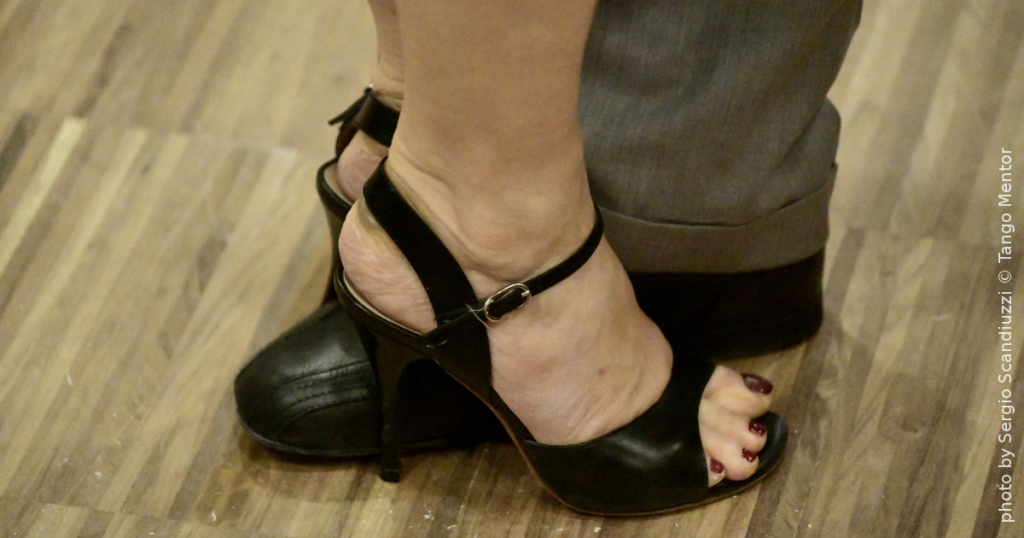
I was sitting on the bench (it was not even a chair) and thinking that this event was a waste of time and money. Not that there were no ladies who were decent dancers, but because guys danced horribly… they were not respecting others on the dance floor, doing aggressive energetic moves and leading high boleos and ganchos. The music was mostly acceptable, but the dance floor was a battlefield.
The only bright spot on the dance floor was an older gentleman, an Italian who danced calmly and with great elegance. Being aware of the situation on the dance floor, he trimmed down his repertoire to its bare bones – hardly doing any sequences. Unfortunately, that was not enough; I could see the frustration on his face when other couples would enter his space in the ronda.
I said he was the bright spot and I picked up some of his tricks to adapt to the chaos, but there was something I didn’t like about dancing so simply. You see, I like minimalism in dancing, but this was too much even for my taste.
I wonder if doing just rock steps and side steps could be considered dancing tango at all? I would say no, but let’s delve deeper into it.
Tango Minimalism is a Virtue
I wrote more extensively about tango minimalism in my article “Tango Minimalism: Small Steps to Heaven” and I still think the best dancers dance without unnecessary fluff. I think it was Michelangelo who said that “everything becomes beautiful if you remove the sufficient” and it’s true, but there’s a point where you can go overboard with it.
Dancing simply gives you the opportunity to focus on the connection and not on the flashy moves, but I don’t think that the connection is the only thing that makes tango a tango.
Moves are important as well and when the dance floor is so crowded that you can’t move, or so chaotic that moving (or even just being there) is risky, I would rather just sit or be at the bar socializing.

If I have to summarize my point, it’s that the connection is the first priority on the list, but it’s not the only thing on the list – moves are there as well.
Examples of Dancing Simply
I chose three videos to showcase my point. Before you see them, I have to say a few things about them – they’re all milongueros from the Golden Age, but in these videos, they perform – which means they dance to entertain the crowd, but I’ve seen videos of them dancing in milongas and there is not much difference.
Example 1: Ricardo Suarez
If you look at Ricardo’s videos, it seems he has only two moves, no matter if he dances milonga, vals, or tango; and no matter what orchestra he’s dancing to. Although I admire his simplicity, I still think it’s too simple – tango can offer so much more. I don’t say it’s bad – maybe he has a way to make his partners enjoy it, but I don’t see it. Maybe I am not able to.
Example 2: Ismael Heljalil
I first discovered Ismael on Tango and Chaos in Buenos Aires. Rick, the author of the site, showed him as an example of simple dancing.
I’ve watched this clip a lot of times, so I’d like to make a couple of comments. You may notice that Ismael is dancing simply—at least on the surface. Like most milongueros, he knows dozens of steps and figures, but he doesn’t use them. In fact, I don’t even see a real giro or a corrida. If I had to give names to anything the dancers do in this film, all I could say is that I see one pause, and I think Ismael’s partner does half an ocho. That’s about it. But that doesn’t mean there isn’t a lot here. Notice how Ismael waits for the music, and builds his energy for the first step. And about 20 seconds into the video, when Laurenz puts in a short riff with the piano, Ismael takes his partner around, right with the pianist’s fingers as they run up the five keys. As you watch it, think about all of the technical aspects of tango we’ve discussed—things like posture, step, balance, connection, and compás.
Tango and Chaos
Ismael dances a bit less simply than Ricardo, but it’s still too simple for my taste. I mean, I can see myself dancing that way, but I would rather add something more. What I want to mention here is that to this day I admire his ability to move in a smooth way, connecting pauses with movement in a seemingly unnoticeable way.
Example 3: Beto Ayala
Alberto dances simply! I think his way best suits my taste and character, and I strive to achieve this. Simple as possible, but not simpler! You can count what he does on the fingers of one hand, and I believe that’s more than enough to dance well.
My work depends on your support! Donate and help me spread the message far and wide. I appreciate every contribution, big or small, as much as you feel you gained value from this article.
From my heart to yours!
Ivica
Securely processed by PayPal
Cacho Dante once wrote, “When they didn’t really know how to dance, they did 20 steps; when they knew a bit more, they did 10; and when they really knew what they were doing, they danced five… but with real quality,” and I totally agree. This shows that in tango, what matters most are the nuances and subtlety, not the number of steps.
On the other hand, I also think that Einstein was right when he said, “Everything should be made as simple as possible, but not simpler.” This reminds us that while simplicity is important, it should never be a goal in itself and come at the expense of the dance’s essence.
Sign up for mu newsletter here:

Leave a Reply